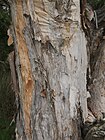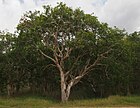Note: This is a project under development. The articles on this wiki are just being initiated and broadly incomplete. You can Help creating new pages.
Melaleuca viridiflora - Broad leaved paperbark
Broad-leaved paperbark commonly known as Melaleuca viridiflora is a plant in the myrtle family and is native to woodlands, swamps and streams of monsoonal areas of northern Australia and New Guinea.
Contents
- 1 Uses
- 2 Parts Used
- 3 Chemical Composition
- 4 Common names
- 5 Properties
- 6 Habit
- 7 Identification
- 8 List of Ayurvedic medicine in which the herb is used
- 9 Where to get the saplings
- 10 Mode of Propagation
- 11 How to plant/cultivate
- 12 Commonly seen growing in areas
- 13 Photo Gallery
- 14 References
- 15 External Links
Uses
Coughs, Colds, Congestion, Headache, Fever, Influenza, Melaleuca viridiflora, Pimples, Diarrhea, Sore throats
Parts Used
Chemical Composition
The main chemical components of niaouli oil are 1,8-cineole, y-terpineol, limonene, a-phellandrene, a and b pinene, linalool and piperitone[1]
Common names
| Language | Common name |
|---|---|
| Kannada | |
| Hindi | |
| Malayalam | |
| Tamil | |
| Telugu | |
| Marathi | NA |
| Gujarathi | NA |
| Punjabi | NA |
| Kashmiri | NA |
| Sanskrit | |
| English | Agrimony |
Properties
Reference: Dravya - Substance, Rasa - Taste, Guna - Qualities, Veerya - Potency, Vipaka - Post-digesion effect, Karma - Pharmacological activity, Prabhava - Therepeutics.
Dravya
Rasa
Guna
Veerya
Vipaka
Karma
Prabhava
Habit
Identification
Leaf
| Kind | Shape | Feature |
|---|---|---|
| broad | oval, flat | Leaves are stiff, thick. smooth, dull dark green with 5-7 longitudinal veins. They are about 7-19 cm long x 2.5-5.5 cm wide. The new growth is hairy |
Flower
| Type | Size | Color and composition | Stamen | More information |
|---|---|---|---|---|
| cylindrical | 5-10 cm x 4-6 cm | greenish-cream, pink blooms | 6 or 9 | the spikes being in groups of 1-4. The seed is formed in small woody capsules 0.3-0.5 cm x 0.4-0.6 cm |
Fruit
| Type | Size | Mass | Appearance | Seeds | More information |
|---|---|---|---|---|---|
| woody capsules | 5–6 mm (0.20–0.24 in) long | clearly grooved lengthwise, Lowest hooked hairs aligned towards crown | scattered along the stem | numerous fine seeds | {{{6}}} |
Other features
List of Ayurvedic medicine in which the herb is used
- Vishatinduka Taila as root juice extract
Where to get the saplings
Mode of Propagation
How to plant/cultivate
A versatile, tropical plant, able to grow in climates ranging from arid to moist, being found at elevations up to 1,000 metres[3]
Commonly seen growing in areas
northern tropical Australia, along streams, in swampy areas, open woodlands.
Photo Gallery
References
External Links
- Ayurvedic Herbs known to be helpful to treat Coughs
- Ayurvedic Herbs known to be helpful to treat Colds
- Ayurvedic Herbs known to be helpful to treat Congestion
- Ayurvedic Herbs known to be helpful to treat Headache
- Ayurvedic Herbs known to be helpful to treat Fever
- Ayurvedic Herbs known to be helpful to treat Influenza
- Ayurvedic Herbs known to be helpful to treat Melaleuca viridiflora
- Ayurvedic Herbs known to be helpful to treat Pimples
- Ayurvedic Herbs known to be helpful to treat Diarrhea
- Ayurvedic Herbs known to be helpful to treat Sore throats
- Herbs with Leaves used in medicine
- Herbs with Twigs used in medicine
- Herbs with common name in English
- Habit - shrub
- Index of Plants which can be propagated by Seeds
- Index of Plants which can be propagated by Cuttings
- Herbs that are commonly seen in the region of northern tropical Australia
- Herbs that are commonly seen in the region of along streams, in swampy areas
- Herbs that are commonly seen in the region of open woodlands
- Herbs









